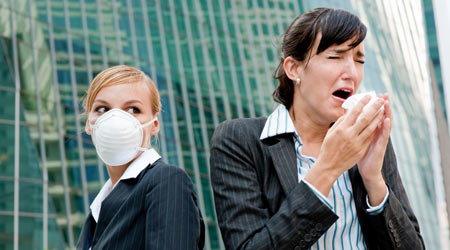
Illnesses occur year-round, but certain illness-causing germs like the common cold, norovirus and influenza peak during the winter months when we spend more time indoors and in close quarters. According to the The Centers for Disease Control and Prevention (CDC), H3N2 viruses are predominant so far this flu season and H3N2-predominant seasons often are more severe, especially for young children and people 65 and older. So as flu activity continues and likely increases this winter, facilities must take measures for prevention.
The CDC also reported that productivity losses linked to absenteeism cost employers $225.8 billion annually in the U.S. (approximately $1,011 per employee due to illness alone), and the common cold is the main reason that adults miss work. In fact, 80 percent of illness-causing germs are spread through touch, which stresses the importance of proper cleaning and disinfecting in the fight against illness and outbreaks.
Statistics like these make promoting safe and healthy work environments not only important for preserving public health, but for helping businesses protect their bottom lines. Here, Clorox Professional Products Company offers ways facilities and staff can do to help keep germs at bay:
• Clean and disinfect regularly. Regular cleaning and disinfection are the best way to treat environmental surfaces to help mitigate the impact of winter illnesses, but effective strategies require a holistic approach that targets germs on hard and soft surfaces.
• Target high-touch surfaces. Objects and surfaces that are frequently-touched such as desks, countertops, doorknobs, keyboards, faucets, phones and elevator buttons need to be disinfected at least once a day with an EPA-registered disinfectant. This is especially important as viruses that cause the common cold and flu can survive on surfaces for hours at a time.
Ready-to-use products and disinfecting wipes are good options for disinfecting high-touch surfaces because they are easy to use, require no dilution and deliver the proper chemical concentration each time they are used, minimizing the risk of human error.
• Don’t overlook soft surfaces. From carpets and curtains to upholstery, soft surfaces can be germ reservoirs. For instance, flu viruses can survive on soft surfaces for up to 12 hours, according to reports from the Journal of Applied Microbiology. Make sure you incorporate decontaminating soft surfaces using products that are EPA-registered to kill illness-causing germs as part of your ongoing approach to facility-wide infection prevention approach.
• Choose the right products and use them correctly. Select products that have label claims to kill bacteria and viruses like influenza and rhinovirus (the leading cause of the common cold) quickly. Remember to always refer to the product label and follow manufacturer’s instructions for use and contact time, or the length of time the disinfectant needs to remain wet on the surface to properly kill germs.
• Practice personal illness-prevention tips. Encourage employees to practice general healthy habits. Discourage sick employees from coming to work and instruct everyone to wash their hands regularly with soap and water especially after emptying waste baskets, touching used tissues, coughing or sneezing or using the bathroom.

 Celebrating BSCAI's 60th Anniversary eBook
Celebrating BSCAI's 60th Anniversary eBook The Down and Dirty on Cleaning in Virus Season
The Down and Dirty on Cleaning in Virus Season How Surfactant Use is Expanding in Commercial Cleaning
How Surfactant Use is Expanding in Commercial Cleaning